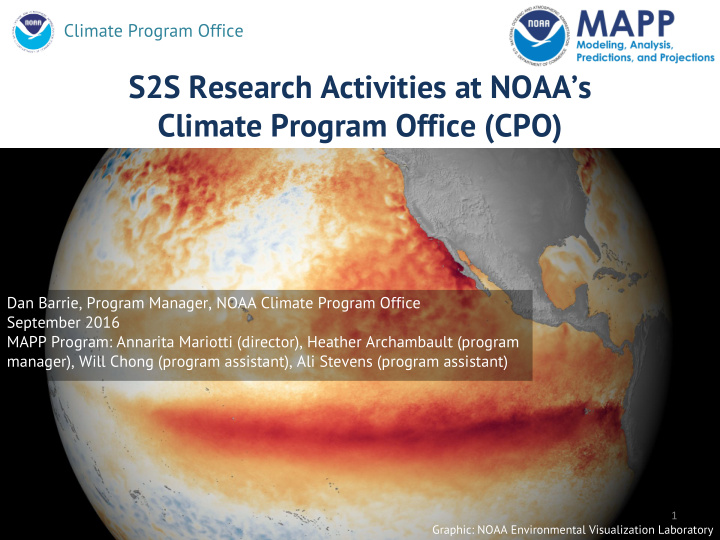



Climate Program Office S2S Research Activities at NOAA’s Climate Program Office (CPO) Dan Barrie, Program Manager, NOAA Climate Program Office September 2016 MAPP Program: Annarita Mariotti (director), Heather Archambault (program manager), Will Chong (program assistant), Ali Stevens (program assistant) 1 Graphic: NOAA Environmental Visualization Laboratory
Climate Program Office OAR Leadership in Subseasonal to Seasonal Prediction Research Climate Program Office (CPO) and predecessor Office of Global Programs (OGP) initiatives have targeted prediction system improvements for 20 years. The figure below from Ek et al. (2003) shows improvements in T2m resulting from an upgraded land model GFDL’s predecessor, the Weather Bureau’s General Circulation Research Section (GCRS), consolidated model development activities into a focused effort in the 1950s. 2 Model genealogy figure from Ben Sanderson (NCAR)
Climate Program Office OAR Leadership Today ESRL led an El Niño rapid response experiment to collect an unprecedented high-resolution data set of observations of tropical conditions and the extratropical response. This data set will be critical to better understanding El Niño and to improving models and forecasts, GFDL’s modeling leadership amongst other outcomes. CPO, through the OAR-NWS continues – the GFDL Climate Test Bed, led the dynamical core was selected development of the North through an intense competitive American Multi Model System, a process to serve as the core of major interagency effort, which the next-generation NWS includes input from seven prediction system. research and operational climate models. 3
Climate Program Office ESRL Research ESRL looking at precipitation impacts in La Nina conditions ● Models agree with Observations for Central Pacific-oriented La Ninas -- dry in west. ● EP model-obs. disagreement: only four events in obs. record (nine for CP) ○ Assuming models are correct, small precip. impact for EP La Nina ○ Both moderate and strong La Ninas impact precipitation in the West ● 4
Climate Program Office ESRL Research Examining skill loss from 1-month lead (left) to 9-month lead (right) ● Why do some verify while others don’t? ○ What about the atmospheric response? ○ 5
Climate Program Office GFDL Research GFDL FLOR ● system shows significant improvements for ENSO prediction Data is available ● -- 33 years, 12 start months, 12 ensemble members CM2.5 and FLOR ● models are publically available. 6
Climate Program Office GFDL Research Smaller grid ● spacing improves simulation and allows phenomena (e.g., mountain snow) to be better represented Lots of data for ● HiFLOR 7
Climate Program Office CPO prediction research The MAPP and Climate Variability and Predictability programs are the current flag bearers for 20 years of CPO/OGP support for seasonal prediction research. Focal areas: • advancing statistical and dynamical modeling, including multi-model ensemble prediction systems • understanding model biases, and improving model processes and physics • developing novel climate reanalysis techniques • improving data assimilation and monitoring systems CPO involved in: Supporting past GEWEX efforts and establishment • of new GEWEX-US office. Coordination with international, interagency, • laboratory, and operational center partners. 8
Climate Program Office MAPP efforts to improve predictions MAPP Notables: Development and support for NMME (research and • real-time). Development of the Climate Forecast System, version 2. • Drought Task Force - NIDIS link • Climate Prediction Task Force • • Subseasonal to Seasonal Prediction Task Force Reanalysis research • Data assimilation • • Predictability and prediction research at the Center for Ocean-Land-Atmospheres (George Mason University) $3M+ in new subseasonal to seasonal research • investments in FY16, including transition to operations work. With co-support from NWS, NESDIS, NASA, and Navy. Targeted improvements to model atmospheric physics. • Evaluation of soil moisture biases with lead time in the CFSv2 reforecasts (Dirmeyer, CFSv2 9 Topical Collection (2013)
Climate Program Office Transition to Operations The Climate Test Bed is a joint effort of NWS and OAR/CPO, focused on enabling the transition of research into operations North American Multi-Model Ensemble Standardized Precipitation Index forecasts derived from NMME North American Land Data Assimilation System 10
Climate Program Office Recent Relevant MAPP Research Hyemi Kim (Stony Brook University) Looking at seasonal prediction of ● AR events CFSv2 does a good job simulating ● ENSO-AR variability in lead-1 DJF forecast (left top and middle) ENSO modulates both AR ● frequency and and average landfall latitude, from: 42 degrees ○ (California/Oregon border; El Nino ) to 44 degrees (Central Oregon ○ coast; La Nina ) 11 Figures courtesy Hyemi Kim
Climate Program Office Drought Task Force California Focus Scientific assessment of the 2011-2014 period of the drought. Causes: Weather conditions -- ● high pressure ridge off West Coast diverted storms Response to SST forcing ● La Nina in first year, then ● continued ocean influence. Scientific assessment of El Nino impacts on California winter precipitation Impacts of El Nino ● typically greater in late winter Continuing questions: ● Southern California ● Winter 2015-2016 forecast ○ higher odds of wet than evaluation Northern California Impact of temperature and ○ 12 ET on the drought
Climate Program Office Relevant new activities Projects focused on: ● Monitoring soil moisture and snow ○ Flash droughts ○ Products on HUCs ○ Climate teleconnections ○ S2S predictability and model performance ○ Atmospheric Rivers ■ Land Surface Feedbacks ■ Troposphere/Stratosphere connections ■ Extratropical storm tracks ■ Tropical controls on U.S. climate and weather ■ The Subseasonal Experiment (SubX) ● Multiple models participating in a coordinated experiment to improve predictions ○ and prediction skill at subseasonal timescales Multiple modeling and prediction centers: NOAA, NCAR, Environment Canada, NASA, ○ Navy Building on NMME experience ○ 13
Recommend
More recommend